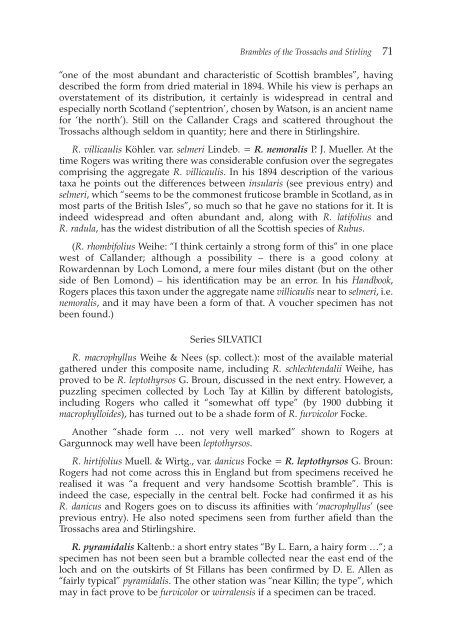the Forth Naturalist Historian - Forth Naturalist and Historian ...
the Forth Naturalist Historian - Forth Naturalist and Historian ...
the Forth Naturalist Historian - Forth Naturalist and Historian ...
Create successful ePaper yourself
Turn your PDF publications into a flip-book with our unique Google optimized e-Paper software.
Brambles of <strong>the</strong> Trossachs <strong>and</strong> Stirling 71<br />
“one of <strong>the</strong> most abundant <strong>and</strong> characteristic of Scottish brambles”, having<br />
described <strong>the</strong> form from dried material in 1894. While his view is perhaps an<br />
overstatement of its distribution, it certainly is widespread in central <strong>and</strong><br />
especially north Scotl<strong>and</strong> (‘septentrion’, chosen by Watson, is an ancient name<br />
for ‘<strong>the</strong> north’). Still on <strong>the</strong> Call<strong>and</strong>er Crags <strong>and</strong> scattered throughout <strong>the</strong><br />
Trossachs although seldom in quantity; here <strong>and</strong> <strong>the</strong>re in Stirlingshire.<br />
R. villicaulis Köhler. var. selmeri Lindeb. = R. nemoralis P. J. Mueller. At <strong>the</strong><br />
time Rogers was writing <strong>the</strong>re was considerable confusion over <strong>the</strong> segregates<br />
comprising <strong>the</strong> aggregate R. villicaulis. In his 1894 description of <strong>the</strong> various<br />
taxa he points out <strong>the</strong> differences between insularis (see previous entry) <strong>and</strong><br />
selmeri, which “seems to be <strong>the</strong> commonest fruticose bramble in Scotl<strong>and</strong>, as in<br />
most parts of <strong>the</strong> British Isles”, so much so that he gave no stations for it. It is<br />
indeed widespread <strong>and</strong> often abundant <strong>and</strong>, along with R. latifolius <strong>and</strong><br />
R. radula, has <strong>the</strong> widest distribution of all <strong>the</strong> Scottish species of Rubus.<br />
(R. rhombifolius Weihe: “I think certainly a strong form of this” in one place<br />
west of Call<strong>and</strong>er; although a possibility – <strong>the</strong>re is a good colony at<br />
Rowardennan by Loch Lomond, a mere four miles distant (but on <strong>the</strong> o<strong>the</strong>r<br />
side of Ben Lomond) – his identification may be an error. In his H<strong>and</strong>book,<br />
Rogers places this taxon under <strong>the</strong> aggregate name villicaulis near to selmeri, i.e.<br />
nemoralis, <strong>and</strong> it may have been a form of that. A voucher specimen has not<br />
been found.)<br />
Series SILVATICI<br />
R. macrophyllus Weihe & Nees (sp. collect.): most of <strong>the</strong> available material<br />
ga<strong>the</strong>red under this composite name, including R. schlechtendalii Weihe, has<br />
proved to be R. leptothyrsos G. Broun, discussed in <strong>the</strong> next entry. However, a<br />
puzzling specimen collected by Loch Tay at Killin by different batologists,<br />
including Rogers who called it “somewhat off type” (by 1900 dubbing it<br />
macrophylloides), has turned out to be a shade form of R. furvicolor Focke.<br />
Ano<strong>the</strong>r “shade form … not very well marked” shown to Rogers at<br />
Gargunnock may well have been leptothyrsos.<br />
R. hirtifolius Muell. & Wirtg., var. danicus Focke = R. leptothyrsos G. Broun:<br />
Rogers had not come across this in Engl<strong>and</strong> but from specimens received he<br />
realised it was “a frequent <strong>and</strong> very h<strong>and</strong>some Scottish bramble”. This is<br />
indeed <strong>the</strong> case, especially in <strong>the</strong> central belt. Focke had confirmed it as his<br />
R. danicus <strong>and</strong> Rogers goes on to discuss its affinities with ‘macrophyllus’ (see<br />
previous entry). He also noted specimens seen from fur<strong>the</strong>r afield than <strong>the</strong><br />
Trossachs area <strong>and</strong> Stirlingshire.<br />
R. pyramidalis Kaltenb.: a short entry states “By L. Earn, a hairy form …“; a<br />
specimen has not been seen but a bramble collected near <strong>the</strong> east end of <strong>the</strong><br />
loch <strong>and</strong> on <strong>the</strong> outskirts of St Fillans has been confirmed by D. E. Allen as<br />
“fairly typical” pyramidalis. The o<strong>the</strong>r station was “near Killin; <strong>the</strong> type”, which<br />
may in fact prove to be furvicolor or wirralensis if a specimen can be traced.



